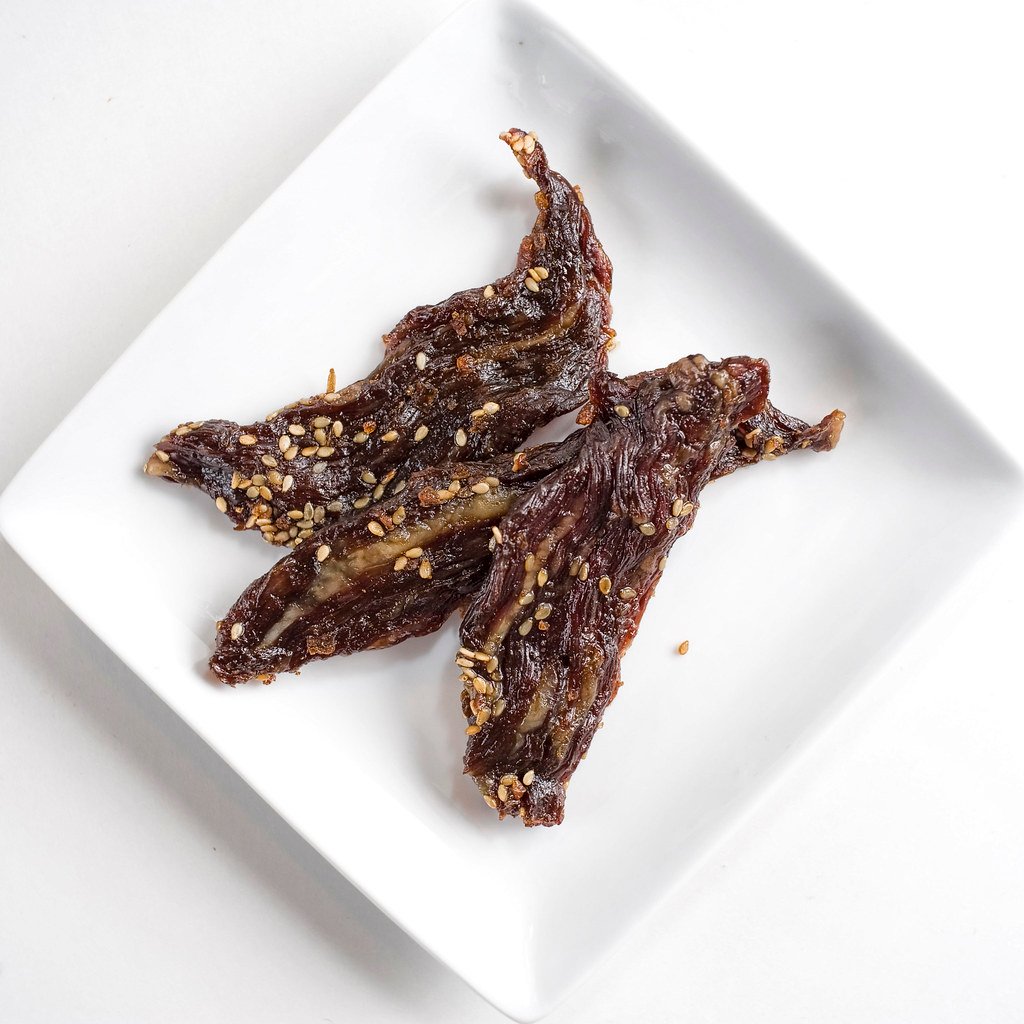Now Reading: How to Make Your Own Jerky for Storage
-
01
How to Make Your Own Jerky for Storage

How to Make Your Own Jerky for Storage
Have you ever found yourself craving a protein-packed snack that doesn’t require refrigeration, but aren’t quite satisfied with the processed options available at the store? Look no further! In the realm of homemade goodies, nothing quite hits the spot like a batch of savory and perfectly seasoned jerky. Not only is it a delicious treat, but making your own jerky allows you to customize flavors and control the quality of the ingredients. Whether you’re an avid hiker, a survivalist preparing for a journey into the wild, or simply seeking a delectable snack for those long workdays, this article will guide you through the art of crafting your very own jerky for storage. Prepare to embark on a flavorful journey that will have you coming back for seconds, and thirds!
Table of Contents
- Getting Started: Choosing the Best Meat Cuts for Homemade Jerky
- Marinating: Unlocking Flavorful Dimensions for Homemade Jerky
- Dehydrating: A Step-by-Step Guide to Drying Homemade Jerky
- Storage and Shelf Life: Tips for Preserving Delicious Homemade Jerky
- Bonus Tips: Exploring Seasoning Variations and Creative Jerky Recipes
- Q&A
- The Conclusion

Getting Started: Choosing the Best Meat Cuts for Homemade Jerky
When it comes to making homemade jerky, selecting the right meat cuts is key to achieving that perfect texture and flavor. Not all cuts are created equal, so it’s important to choose wisely. Here are some top picks to consider:
- Lean cuts: Opt for lean meats like beef sirloin, eye of round, or flank steak. These cuts have less fat, allowing the jerky to dry properly and last longer.
- Marbled cuts: If you prefer a juicier and more flavorful jerky, go for cuts with some marbling, such as beef ribeye or tri-tip. The intramuscular fat helps create a melt-in-your-mouth experience.
- Poultry options: Don’t limit yourself to just beef or pork. Chicken and turkey can make fantastic jerky as well. Choose boneless, skinless cuts like chicken breasts or turkey tenderloin for the best results.
Remember, the key to great jerky lies in the meat selection. While these suggestions are a great starting point, feel free to explore other cuts too. Experimentation is part of the fun, and who knows, you might stumble upon your own favorite meat cut for that perfect homemade jerky!

Marinating: Unlocking Flavorful Dimensions for Homemade Jerky
When it comes to creating mouth-watering homemade jerky, marinating is the key to unlocking a world of flavorful dimensions. This essential step infuses the meat with a tantalizing blend of spices and seasonings, resulting in a delectable snack that is simply irresistible.
Marinating your jerky not only enhances its taste but also helps to tenderize the meat, ensuring a juicy and tender final product. By allowing the flavors to penetrate deep into the fibers, you’ll create a jerky that explodes with a harmonious blend of savory, sweet, and tangy notes.
There are endless possibilities when it comes to marinating your jerky. From classic combinations like soy sauce, Worcestershire, and garlic, to more adventurous options like teriyaki, honey, and ginger, the choices are as diverse as your taste buds allow. Experimenting with different marinades opens up a world of culinary exploration, allowing you to create a personalized jerky recipe that is uniquely yours.
Here are a few tips and tricks to make the most out of your marinating process:
- Be patient: Marinating is an art that requires time. Allow your jerky to soak in the marinade for at least 12-24 hours, or even longer for more intense flavors.
- Use high-quality ingredients: Opt for fresh herbs, spices, and quality liquids to achieve the best results. Don’t be afraid to experiment with unique combinations!
- Think beyond the traditional: While traditional marinades are delicious, try adding a twist with unexpected ingredients like citrus zest, maple syrup, or even a splash of bourbon. Let your imagination run wild!
- Consider the balance of flavors: Aim for a harmonious blend of salty, sweet, acidic, and umami flavors. Taste your marinade before adding the meat to ensure the balance is just right.
So, ready to take your homemade jerky to new heights? Unleash your creativity, experiment with flavors, and let the marinating process transport you to a world of irresistible tastes and aromas.

Dehydrating: A Step-by-Step Guide to Drying Homemade Jerky
Are you a jerky enthusiast looking to take your culinary skills to the next level? Look no further! In this comprehensive guide, we’ll take you through the art of dehydrating your very own mouthwatering homemade jerky. It’s time to roll up your sleeves and embark on a flavorful adventure.
Step 1: Choosing the Meat
Start by selecting the perfect cut of meat for your jerky. Lean meats like beef, turkey, or venison work best. Trim away any excess fat to prevent spoilage during the drying process.
Step 2: Marinade Magic
Now it’s time to infuse your chosen meat with a burst of flavor. Create a marinade using your favorite combination of spices, herbs, and seasonings. Try experimenting with soy sauce, Worcestershire sauce, garlic powder, onion powder, and smoked paprika for a tantalizing taste.
Step 3: Slicing and Dicing
Grab a sharp knife and slice your marinated meat into thin strips. Aim for a thickness of around 1/8 to 1/4 inch. Remember, the thinner the slice, the quicker it will dry.
Step 4: Time to Dehydrate
Place the meat strips on the dehydrator trays, ensuring plenty of space between each piece for proper air circulation. Set the dehydrator to a temperature of around 155°F (68°C) and allow the magic to happen over the course of 4-6 hours. Keep an eye on your jerky, flipping it periodically for even drying.
Step 5: Test and Store
When your jerky is firm and bendable with no signs of moisture, it’s time to taste-test your delectable creation. Allow it to cool completely before transferring it to an airtight container or vacuum-sealed bag for prolonged freshness.
Now that you’re armed with this step-by-step guide, put your skills to use and share the joy of homemade jerky with friends and family. Happy dehydrating!
Storage and Shelf Life: Tips for Preserving Delicious Homemade Jerky
When it comes to homemade jerky, proper storage and shelf life are essential to ensure you can savor your delicious creation for as long as possible. Follow these tips to preserve the flavor and quality of your homemade jerky:
1. Temperature and Humidity: Store your jerky in a cool, dry place, preferably at temperatures below room temperature. Excessive heat and humidity can lead to spoilage and an unpleasant texture in your jerky. Avoid storing it in areas near direct sunlight or near a heat source.
2. Air-tight Packaging: To maintain the freshness of your jerky, store it in air-tight containers or resealable bags. This will help prevent moisture and oxygen from reaching the jerky, which can cause spoilage. Vacuum-sealing your jerky can also be an effective option to extend its shelf life.
3. Refrigeration or Freezing: If you anticipate storing your homemade jerky for an extended period, consider refrigerating or freezing it. When refrigerated, jerky can last for several weeks, while freezing can extend its shelf life for several months. However, it’s essential to wrap it tightly to prevent freezer burn and maintain its flavor.
By following these storage and shelf life tips, you can ensure that your delicious homemade jerky stays fresh and flavorful until the last bite. Whether you’re savoring it on hikes, road trips, or as a protein-rich snack, your homemade jerky will be the epitome of mouthwatering goodness!
Bonus Tips: Exploring Seasoning Variations and Creative Jerky Recipes
One of the most exciting aspects of making jerky at home is the ability to experiment with different seasoning variations and create unique and flavorful recipes. The possibilities are truly endless when it comes to adding a personal touch to your jerky. So, why not take a leap and explore some exceptional seasoning variations that will tantalize your taste buds? Here are some bonus tips to get your creativity flowing:
1. Embrace the Heat: If you appreciate the fiery flavors, try experimenting with spicy seasonings like cayenne pepper, chipotle powder, or crushed red pepper flakes. The fiery kick will add a new dimension to your jerky and satisfy your craving for heat.
2. Go on a Sweet Journey: Introduce a touch of sweetness to your jerky by incorporating ingredients like honey, brown sugar, or maple syrup into your marinade. The delicate balance between the salty and sweet flavors will make your jerky an instant hit.
3. Unleash the Flavor Bombs: Want to take your jerky on a flavor-packed adventure? Add aromatic herbs and spices like rosemary, thyme, garlic powder, onion flakes, or even smoked paprika. These flavorful additions will elevate your jerky to a whole new level.
Remember, don’t be afraid to experiment and trust your taste buds. Creating unique jerky recipes is all about embracing your creativity and having fun in the kitchen. So, grab your apron, don your chef’s hat, and let your imagination run wild as you embark on a journey to discover the perfect jerky recipe that suits your taste. Happy experimenting!
Q&A
Q: What is jerky and why is it a good option for storage?
A: Jerky is a lean, dried meat product that is rich in protein, portable, and has an extended shelf life. It is ideal for storage as it can be preserved without refrigeration, making it perfect for camping trips or emergency situations.
Q: What kind of meat works best for making jerky?
A: Lean cuts of meat such as beef, turkey, venison, or even wild game like elk or bison work best for making jerky. The key is to choose a protein source that has minimal fat content for better preservation and drying.
Q: Can I make jerky without a dehydrator?
A: Absolutely! While a dehydrator is the most efficient method for making jerky, you can still successfully make it without one. An oven set to a low temperature or even air-drying in a cool, dry place can be used as well.
Q: How important is marinating the meat before drying?
A: Marinating the meat before drying is crucial as it not only adds flavor but also helps in tenderizing and preserving the jerky. The longer you marinate, the better the flavor will be, typically ranging from a few hours to overnight.
Q: How long can homemade jerky be stored?
A: Properly stored homemade jerky can last up to 1-2 months in an airtight container in a cool, dry place. Keep in mind that the duration may vary depending on the type of meat, marinade, and storage conditions.
Q: What are some creative flavor variations I can try?
A: The possibilities for flavor variations are endless! You can experiment with different marinades like teriyaki, spicy sriracha, honey mustard, or even a tangy BBQ sauce. Feel free to add spices, herbs, or even a touch of sweetness like brown sugar to customize your jerky.
Q: Can I freeze homemade jerky for long-term storage?
A: Yes, freezing homemade jerky is an excellent option for long-term storage. Place the jerky in a freezer-safe bag or container and freeze for up to 6 months. Thaw the jerky at room temperature before enjoying its deliciousness again.
Q: Are there any safety precautions to keep in mind while making jerky?
A: Absolutely! When making jerky, it’s important to handle raw meat properly to avoid any cross-contamination. Always marinate in the refrigerator, use clean utensils and surfaces, and ensure the jerky reaches a safe internal temperature of 160°F (71°C) to kill any potential bacteria.
The Conclusion
As we conclude our jerky journey, we hope you’ve discovered the gratifying world of homemade jerky and learned how to preserve your favorite cuts of meat with ease. The art of transforming ordinary slabs into tantalizing strips, effortlessly extending their shelf life, is now within your grasp.
With the knowledge gained, you can bid farewell to store-bought jerky and embrace the freedom to experiment, personalize, and savor flavors that suit your palate. Imagine the satisfaction of biting into a slice infused with your chosen seasonings and marinades, knowing that it emerged from your own kitchen.
Remember, the key to successful jerky making lies in patience and precision. From selecting the perfect meat cuts to mastering the art of drying, each step contributes to the delectable end result. The delicate balance of flavors, the satisfyingly chewy texture, and the heavenly aroma will reward your efforts and elevate your snacking experience to new heights.
As you embark on this jerky-making adventure, never forget the versatility of this culinary delight. Be it fuel for your outdoor adventures, a protein-packed snack for your hectic workdays, or a thoughtful gift for your fellow jerky enthusiasts, the possibilities are as endless as your imagination.
So, roll up your sleeves, gather your ingredients, and dive into the world of homemade jerky. Let your creativity run wild, and craft bites of deliciousness that will keep you and your loved ones happily munching for months to come. Embrace the preservation prowess you now possess and embark on a journey to satisfy your cravings, unleash flavors, and make the most out of your culinary adventures.
Bon appétit, dear readers, and happy jerky-making!
As an affiliate, my content may feature links to products I personally use and recommend. By taking action, like subscribing or making a purchase, you’ll be supporting my work and fueling my taco cravings at the same time. Win-win, right?
Want to read more? Check out our Affiliate Disclosure page.





